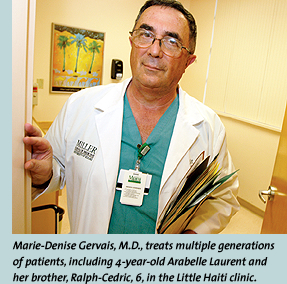![]()
Changing the
Ways of Vascular Surgery
![]() he
traditional definition of a vascular surgeon is one who surgically treats
diseases of the arteries and veins.
he
traditional definition of a vascular surgeon is one who surgically treats
diseases of the arteries and veins.
But Juan C. Parodi, M.D., a new faculty member of the Miller School of Medicine, has created a new paradigm for vascular surgeons. The professor of surgery and director of endovascular surgery in the DeWitt Daughtry Family Department of Surgery pioneered several non-invasive techniques that have decreased morbidity and mortality and reduced the need for surgery itself on patients suffering from vascular diseases.
 Parodi joined the faculty last spring from the Washington
University School of Medicine in St. Louis, where he spent three years
as professor
of surgery. He received his medical degree from the Universidad del
Salvador in Buenos Aires, Argentina, and spent several decades working
in both
South America and the United States before moving here permanently
in 2003. He has received several honors and awards, including the Jacobson
Innovation Award from the American College of Surgery and was named
the
first recipient of the Society for Vascular Surgery Medal for Innovation.
Parodi joined the faculty last spring from the Washington
University School of Medicine in St. Louis, where he spent three years
as professor
of surgery. He received his medical degree from the Universidad del
Salvador in Buenos Aires, Argentina, and spent several decades working
in both
South America and the United States before moving here permanently
in 2003. He has received several honors and awards, including the Jacobson
Innovation Award from the American College of Surgery and was named
the
first recipient of the Society for Vascular Surgery Medal for Innovation.
Parodi is the first physician in the world to treat patients using endovascular repair, a technique he created to prevent aortic aneurysms from rupturing. Standard aortic aneurysms require five to seven days of hospitalization—Parodi’s patients typically go home within 12 hours. “It’s like going to the dentist,” one patient told him.
Parodi is also the only physician in the world who uses a new method of protecting the brain, called flow reversal, when stents need to be placed in carotid arteries that have blockages. Flow reversal reduces the risk that particles from the blockage will break off during stenting and go to the brain. Parodi and a team from the Miller School will be traveling to ten different medical centers across the country to teach this technique. Another treatment Parodi has introduced includes a way to use prostaglandins for blue toe or blue finger syndrome, which used to automatically require an amputation.
“Some people hate me because I’m taking the surgery out of vascular surgery,” Parodi jokes.
Not Darwin Eton, M.D., chief of the Division of Vascular Surgery, who worked hard to bring Parodi to the Miller School. “Dr. Parodi’s experience dwarves anybody’s in this part of the world,” says Eton. “The equipment and technology he has developed have changed the lives of thousands of people worldwide.”
Parodi hopes to continue to
positively affect the lives of many patients. “Someone’s
going to come along with a better technique, and I’m going to adopt
that technique. It always comes back to doing what’s best for the
patient,” Parodi says.